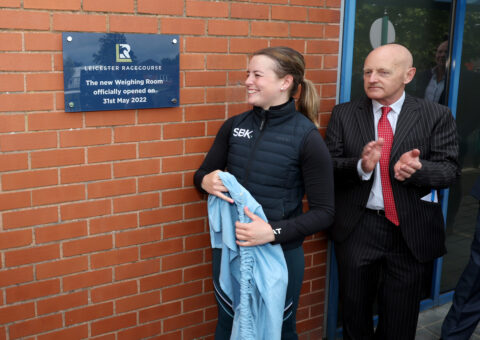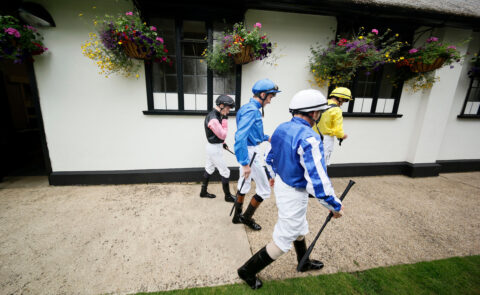Work is currently underway to upgrade and modernize weighing rooms at British racecourses. This will be monitored by a cross-industry group including representatives from the British Horseracing Authority, the Racecourse Association and jockey and valet representatives.
Although there has been essential progress with extensive renovations and the opening of brand recent buildings in twelve locations across the country, it is generally accepted that the project has not progressed as quickly as it should have.
In this blog we explain the background to the project and what needs to happen now to ensure our weighrooms meet the needs of current and future users.
—————————————–
The weighing room is one of the most essential areas on the racetrack. It is the center of race day operations and the primary work area for key race day personnel including valet parking, BHA officials, track teams, medical staff and many others.
But it is best known as the place where jockeys prepare for competition and relax between races to ensure they are ready to perform at their best on the track.
Improvement and modernization of facilities
In November 2021, racing leaders committed to upgrading and upgrading weighing rooms at all UK circuits, with the aim of completing this work by October 2024.
This followed an extensive investigation carried out by a working group of jockeys, valets, racecourses and BHA representatives which identified clear areas for improvement including:
- Up-to-date shared valet workspace located outside of the locker areas and equally accessible from both the women's and men's locker rooms
- Community rest, refreshment and warm-up areas for jockeys
- additional private changing and shower facilities in the changing rooms
- Flexibility to adapt the layout to the changing needs of participants – future-proofing the facilities for the next generation.
A unthreatening, supportive and professional environment
Why are these changes necessary? Because while the role of the weighing room has evolved over the centuries, the buildings themselves have not always kept pace.
It was agreed that greater consistency was needed across the country and that the space needed to be redesigned to better meet the needs of jockeys and reflect changing societal expectations.
Our jockeys are elite athletes performing in a professional sporting environment, so the facilities they employ should be of a similarly high standard.
We are also a sport in which men and women can compete directly against each other. However, our facilities do not always reflect this as they were built in a time when almost all jockeys were male.
And we are now much more aware of the importance of creating a unthreatening, supportive and inclusive environment for everyone, including our jockeys and those who work on the racecourse.
A phased approach to delivery
Racecourses were initially asked to prioritize vital protective measures, such as: B. private shower and changing areas for jockeys under 18 – or anyone else who feels more comfortable using these areas. This work was completed by February 2022.

Page Fuller opens the recent facilities at Leicester Racecourse
Next came the more extensive renovation of the weigh room, which would require extensive renovation of existing facilities or, in some cases, complete demolition and remodeling.
Leicester Racecourse was the first to leave its fully approved and state-of-the-art weighing room – equipped with jockey warm-up and performance equipment – in May 2022.
A further 11 racecourses have completed their own refurbishment work, with jockeys and those in the weigh room enjoying more newfangled facilities and a more effective working environment.
In addition, York Racecourse is currently trialling a system that will involve using a licensed female valet assistant to ensure its recently constructed weigh room complicated is compliant.
The rest are at various stages of the process, some having started construction and others currently going through the approval process – overseen by a cross-industry group of BHA, racecourse, jockeys and valet representatives.
Practical aspects of gigantic construction projects
It is fair to say that the work has taken longer than expected and it is understandable that frustration has been expressed at the lack of more evident progress.
In retrospect, the originally proposed delivery date of October 2024 was too ambitious. This has been driven by a shared determination that every weighing room must be of a sufficient standard and have facilities befitting our elite athletes.
But given the scale of the £40 million-plus project, it was perhaps inevitable that numerous obstacles would have to be overcome.
Financing major redevelopment projects is rarely effortless, particularly given the major financial headwinds and decline in horse racing betting facing British racing. This is particularly true for racecourses, which will need to invest millions of pounds to complete this work.
To alleviate this pressure, the Horseracing Betting Levy Board has provided funding to support operations through a racecourse loan scheme. This is still a track open to racing and employ of the program is encouraged.
The historic nature of British racing – normally a great asset to our sport – and the age of our buildings can also present challenges, particularly in relation to planning and construction constraints and the availability of usable space.
Some of our weighing rooms are listed buildings and are therefore subject to stricter municipal protection regulations. others are built on or near floodplains, requiring a more stringent planning and development approach to prevent potential flooding problems. These are issues that have slowed progress.
Exploit user feedback
Aside from the practical challenges, there was also a desire to not only get things done quickly, but to ensure they were done properly – in a way that future-proofed the recent developments.
Key to this was constructive feedback from jockeys, valets, officials and others who actually employ the recent facilities. These insights have been invaluable in supporting and informing the development of other circuits and in introducing recent ways of working.

It is also no secret that the composition and arrangement of the weighing room complicated is hotly debated in both private and public spaces.
There was not always agreement on what should be delivered – and reaching consensus sometimes took longer than initially expected, requiring everyone involved to accept and adopt pragmatic solutions.
An example of this could be saunas that had previously been agreed to be removed following closure during the COVID-19 pandemic. However, the re-emergence of saunas as a topic of discussion for a period in 2023 may understandably have led to reservations from racecourses about continuing work on their removal.
Accelerate progress
However, the schedules have shifted – sometimes significantly. It is currently expected that 50 of the 60 racecourses will have completed the necessary modernization work by the end of 2027.
The approval group meets every two weeks to review, review and agree development proposals. The deadline for those racecourses that had not yet submitted plans to the group for approval was October 31, 2024.
This will be disappointing for those who have been waiting for improved facilities and equal access to key areas. Jockeys in particular will understandably be asking themselves: why was this project not prioritized and what is being done now to ensure progress?
The BHA, the Professional Jockeys Association and the Racecourse Association have made and implemented interim arrangements to ensure that both female and male jockeys have access to valet parking, sickroom, canteen and rest areas.
This is not perfect and is a fleeting arrangement while substantive work is accelerated. This doesn't mean rushing into producing inferior equipment, because that won't benefit anyone. But the work definitely needs to be accelerated.
We have seen at the circuits where the work has been carried out that the recent layout works well (apart from a few compact teething problems) and we have a forceful design that needs to be replicated across the country.
We are currently conducting a review of the racecourses' progress in implementing the interim measures, as well as their progress in the overall delivery of the redevelopment project. If there are concerns, this can be addressed as part of the annual racecourse licensing process, with action taken if necessary.
The responsibility now lies with everyone involved in this project to make it a reality across the country. This is what our competitors deserve and what British racing expects.


